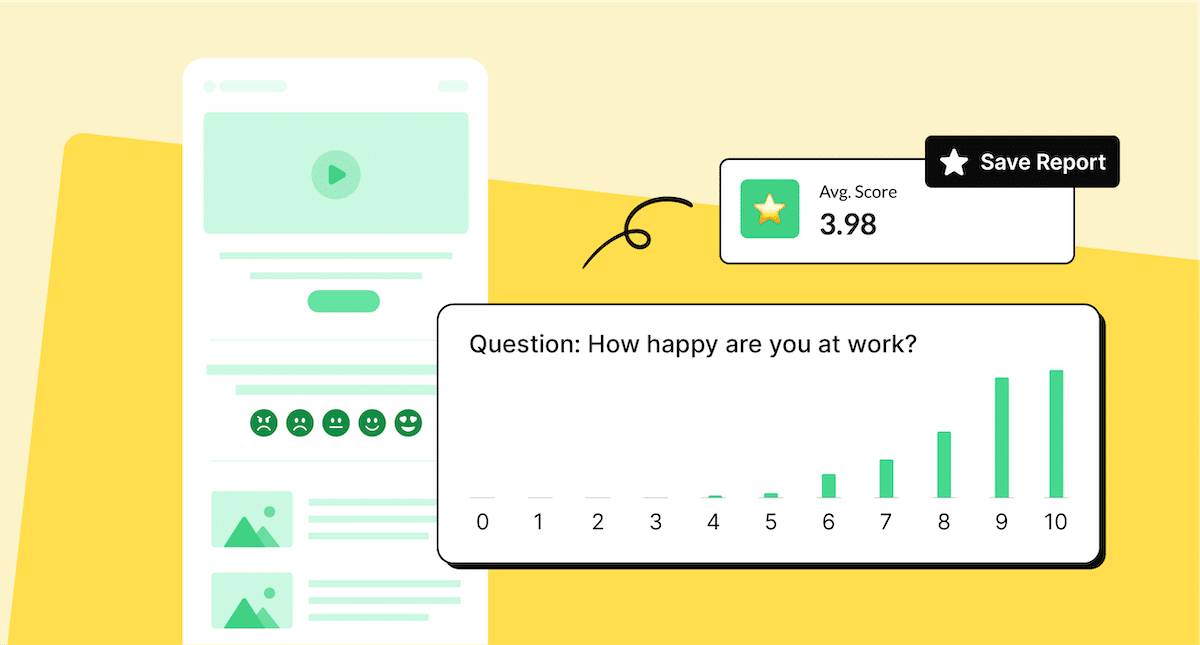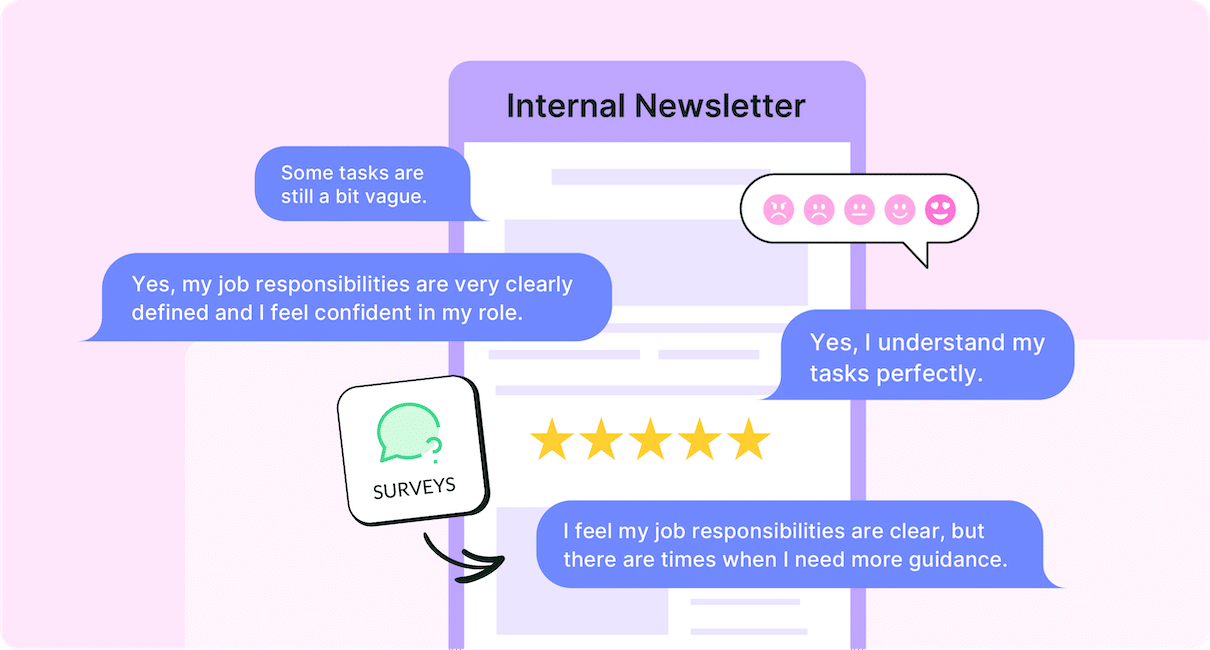Employee feedback is essential for understanding and improving your business. But getting honest, consistent, and actionable feedback is no easy task. In this post, we’ll look at 15 types of employee surveys, and survey questions to ask to help you gather better feedback from your teams.
Top employers all have one thing in common: they recognize that their staff is the company’s greatest asset.
Employee surveys are a powerful tool for tapping into employee insights. They also show your employees that their input is valued, which boosts morale and engagement.The key is creating surveys that suit the scope and goals of your assessment as well as your employees’ schedules and priorities.
By understanding the different types of employee surveys available and when to use them, you can collect valuable employee feedback. You’ll also be able to make better use of it.
See how ContactMonkey’s employee survey features make it quick and easy to gather feedback. Add pulse surveys, eNPS surveys, custom polls, star ratings, emoji reactions and more to your emails! Start taking advantage of the many benefits to two-way communication.
Take a self-guided tour of ContactMonkey
See how our key features can streamline your internal communications.
Take product tour

Things to Consider Before Starting Your Employee Survey: Best Practices
Before you launch your employee survey, there are a few things you’ll need to think about.
First, you have to understand what you want to achieve with your survey. The key is having clearly defined goals that can guide your survey structure and style. From there, you can determine your feedback metrics as well as survey frequency, scope, and key survey questions for employees.
Here’s the breakdown:
Set clear objectives
Having well-defined objectives for your survey is at the heart of it all. Is your goal to learn whether employees find your new software useful? Do you want to know if your staff has enough opportunities for growth? Ambiguous objectives will lead to ambiguous answers so make sure you know exactly what you’re looking for.
Establish your metrics
Your survey metrics go hand in hand with your survey objectives. They create a framework for your feedback process.
With set metrics, you can easily see when you’ve reached the objective of your survey and what it reveals. For instance, if you’re measuring employee engagement, a key survey metric could be the percentage of your employees who agree/disagree that management values their ideas and input.
Create a schedule for your survey
Your survey frequency should consider the scope and objectives of your survey as well as your teams’ capacity and schedule.
If you’re conducting a survey regularly, make sure to keep it short and focused. Be mindful of your employees’ time. Also, keep in mind the type of survey you’re conducting. Since employee engagement fluctuates often, this type of survey should be sent regularly. On the other hand, a change management survey should be done at specific intervals during the company transition.
Pick the right employee survey tools and software
Tools like ContactMonkey take the work out of creating and scheduling employee surveys. They let you simplify and streamline the survey process by embedding quick, concise, and focused surveys right into your employee emails.
You’ll have the option to use more engaging and simple response features such as emoji reactions, thumbs up/down, dichotomous scale, and eNPS survey questions. Most importantly, you’ll be able to track and compare survey results over time. This way, you can gather and monitor feedback for continuous improvement.
Choose the right question style
Whatever your survey objectives, your questions have to be clear, straightforward, and in tune with your survey goals. Pulse surveys are great for the job because they centre around a single focused question that employees can answer directly in their employee newsletter.
But you’ll also have to choose the right question format. Here are a few options to keep in mind:
Likert Scales: This style of question helps determine the strength or intensity of an attitude. They usually offer five options in a range, but can go up to seven.
Dichotomous Scales: This is a fancy word for questions that have two possible answers. These can include answers such as yes/no, agree/disagree, true/false, and more.
eNPS: Employee Net Promoter Score determines how many of your staff would recommend your workplace to others. Standard eNPS questions include: “On a scale of 1-10, how likely are you to recommend this workplace to others?”
Anonymous Commenting: This type of response is great for expanding on quantitative or yes/no answers. It’s also good for getting honest feedback on challenging questions such as how an employee feels about their senior leadership team.
Create and send employee surveys for feedback
Engage staff with pulse surveys, eNPS surveys, reusable surveys, custom polls, and more. Ready to send modern emails?
Explore survey features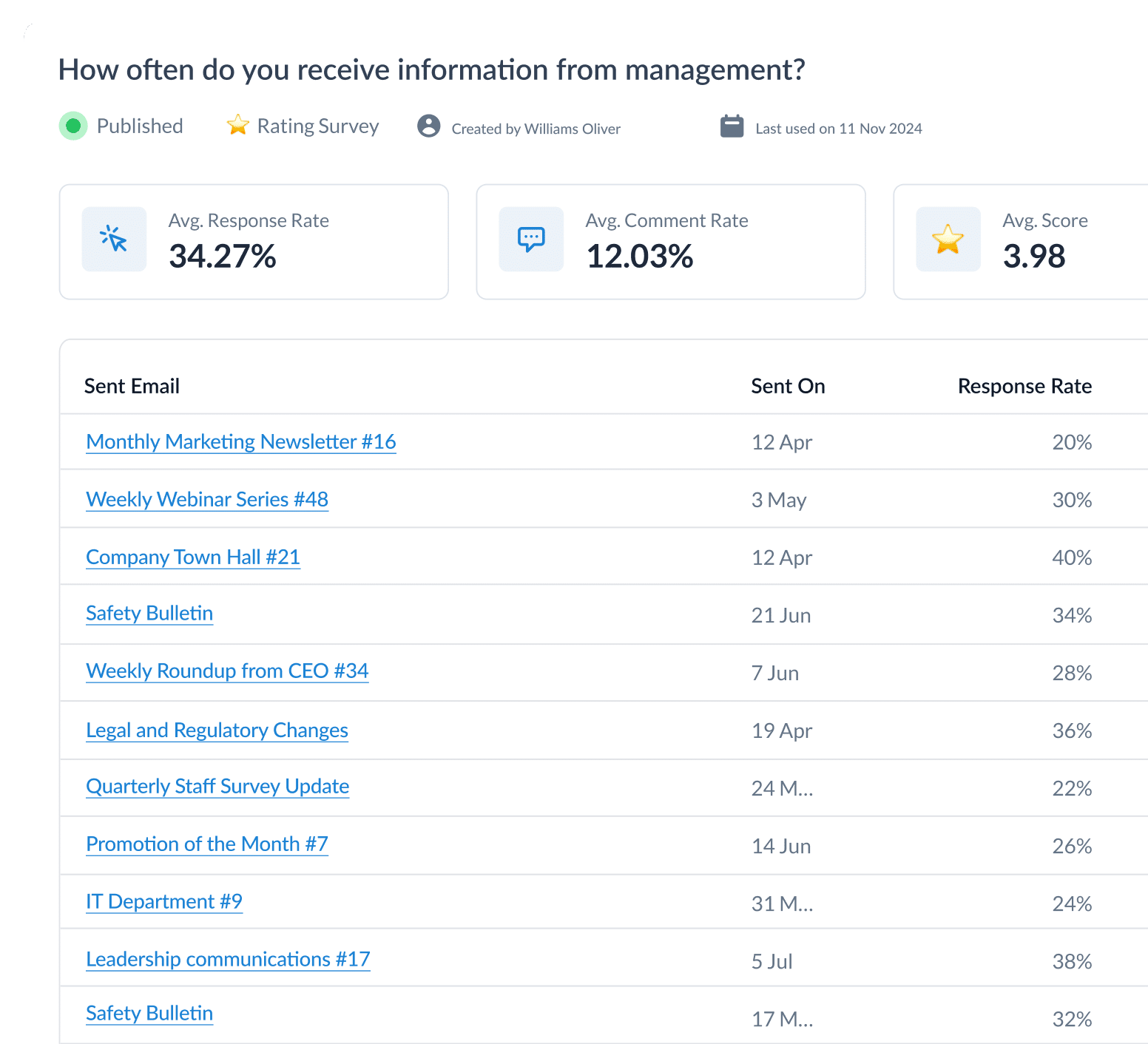
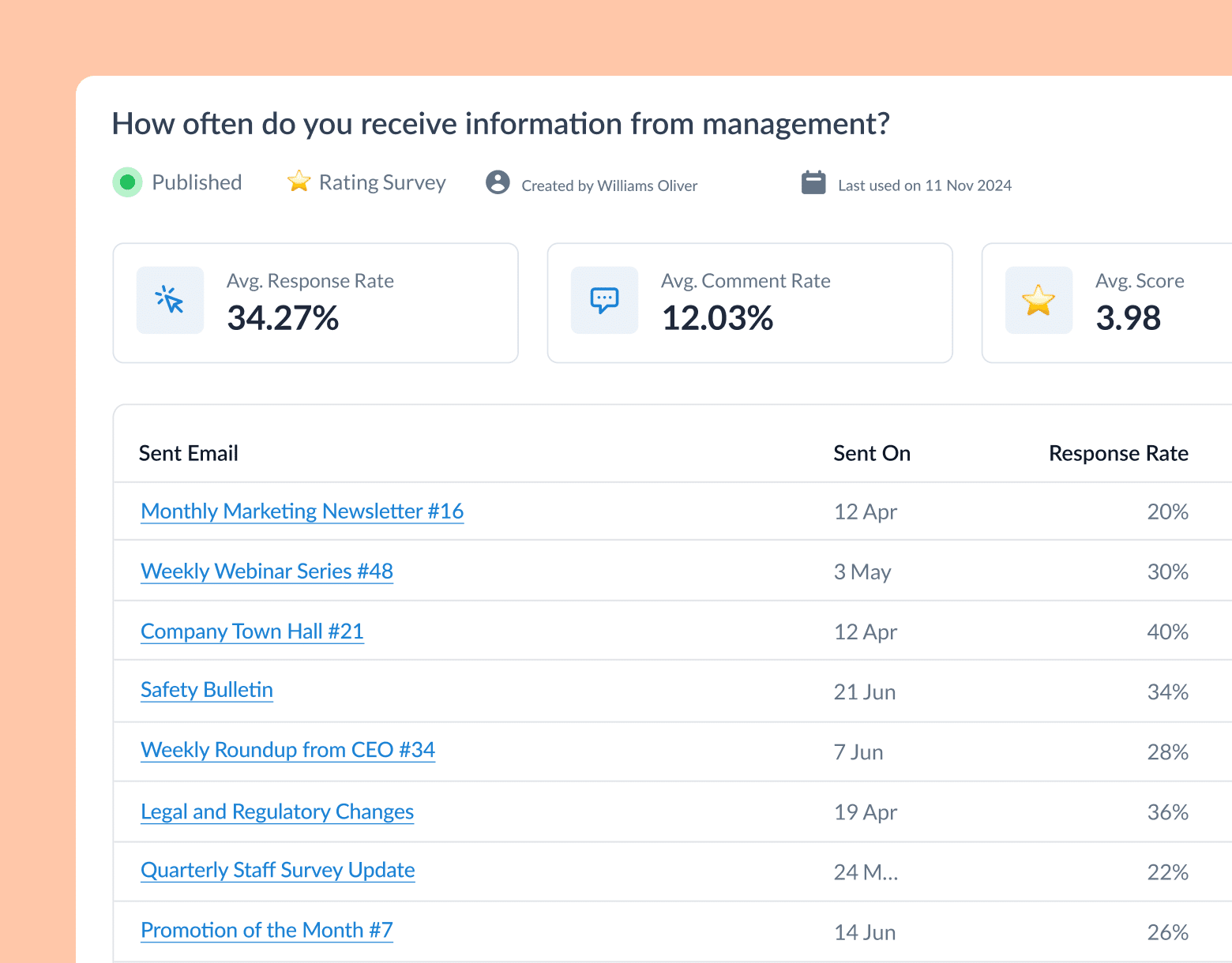
15 Types of Employee Surveys
Now that we’ve covered the prep process for conducting your employee survey, it’s time to get down to business. We’ll look at 15 different types of employee surveys, their individual benefits, and how you should use them.
By the end of this list, you’ll have a good idea of how each type of employee survey works and how to improve employee survey response rates. You can also check out our employee survey templates for usable examples of content you can include in your surveys.
1. Employee engagement surveys
Employee engagement surveys look at how connected employees feel to their workplace. That includes their sense of motivation in their roles, how aligned they are with company values, and their support for senior leadership.
Remember, employee engagement surveys need to be conducted often. That being the case, pulse survey questions are usually the best way to collect ongoing feedback..
With ContactMonkey, you can send employee pulse surveys right from your weekly newsletter, keeping feedback simple, straightforward, and continuous. Employees can complete pulse surveys with a single mouse click, which increases the likelihood that they’ll take the time to do so.
Survey questions to include:
- Does your company’s mission/vision inspire you? (yes/no)
- Do you find your work to be meaningful? (yes/no)
- How do you feel when you come into work every day? (emoji reactions)
- On a scale from 0-10, how likely are you to recommend our organization to your family or friends? (eNPS)
2. Employee satisfaction surveys
With a satisfaction survey, employers can gather insights on how happy employees are with specific aspects of their job and company. Most notably, these include compensation and benefits, workload, schedules, company policies, and workplace diversity.
These surveys are useful for planning company changes, adjusting company policies, and improving work conditions.
Since employees may feel uneasy expressing their dissatisfaction to their boss, make sure that your employee satisfaction survey is anonymous—this can even be done when you create an anonymous survey within the platform. With ContactMonkey’s pulse surveys, employers can give staff the option to expand on yes/no or likert scale answers with anonymous comments. Simply switch the ‘On’ button on the comments tab and let employees provide honest and authentic feedback so you can measure employee satisfaction.
Survey questions to include:
- I feel satisfied with my compensation and benefits. (scale rating)
- I would describe my workload as______.
- How do you feel when you come in to work every day? (emoji reaction)
- Do you believe that work is distributed evenly across your teams? (yes/no)
3. Employee performance surveys
If you want to learn where your teams’ strengths and weaknesses lie, employee performance surveys are your go-to instrument. This type of employee survey lets you pinpoint gaps and opportunities in management, training, resources, and information provision.
Employee performance surveys usually take the form of self-evaluations. They’re especially handy when you’ve noticed a change in your teams’ performance or productivity.
Survey questions to include:
- I feel focused at work. (scale rating)
- I easily adapt to new situations and challenges. (scale rating)
- When I have extra time, I often take on additional tasks or responsibilities. (yes/no)
- How would you rate your overall performance this month? (scale rating)
Start two-way conversations and employee feedback loops
Learn how to engage staff with pulse surveys, content ratings and reactions, custom polls, and more. Ready to send modern emails?
See engagement features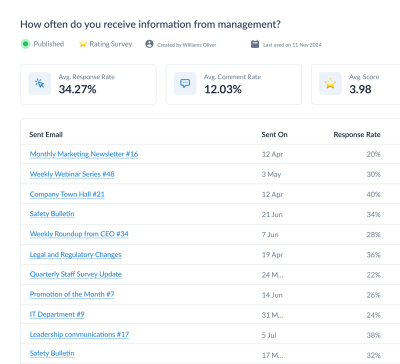

4. Professional development surveys
When employees have access to professional development opportunities at their company, they’re up to 2.5% more likely to be engaged in their job. Professional development surveyslet you gauge whether your employees have enough resources for career growth within your company and what areas of career development they’re interested in.
Feedback on professional development opportunities may not be as clear cut as feedback on, say, employee benefit surveys. Staff may have access to internal training and courses but they may find them lacking or not interesting.
Likert scales are great for these types of questions as they allow employees to express their feedback on a scale. With ContactMonkey’s pulse surveys, you can make your likert scale responses more precise and engaging by using star ratings or emoji reactions.
Survey questions to include:
- I can see a clear career path in this organization. (scale rating)
- I have sufficient opportunities for professional development at my company. (yes/no)
- I would like to learn more about____ aspect of my company.
- In terms of training and professional development, I would like to see my company continue to offer ____.
5. Employee attitude surveys
Employee attitude surveys let you gauge the overall mood of your workplace at a specific moment in time. They’re incredibly useful in identifying problems with workplace culture, gaps in information or resources and lack of work-life balance. These types of employee surveys tend to be completed anonymously to allow employees to express themselves fully.
For this staff survey, likert scale questions will allow employees to fine-tune their responses to their moods. To make this type of employee survey more interesting and dynamic, use ContactMonkey’s survey email templates and emoji responses. Your emojis represent a scale of reactions from satisfaction to dissatisfaction and offer your employees a few different options for more accurate responses.
Survey questions to include:
- I always get constructive feedback about my work. (scale rating)
- If a challenge arises, I know I can get support from my peers or team leaders. (yes/no)
- I feel that my work is appreciated. (scale rating)
- When a change is about to happen at work, I know I’ll be informed/consulted. (yes/no)
6. 360 survey
The goal of this type of employee survey is to get a variety of perspectives on a particular employee’s performance. 360 surveys gather feedback from different sources including team leaders, managers, peers, and self-evaluation.
For this type of employee survey, questions are often presented as statements with responses covering a scale from “Excellent” to “Needs improvement.” As this is a more comprehensive assessment, questions should be broken down into categories such as accountability, communication and leadership.
Survey questions to include:
- [Employee] takes responsibility/ownership for mistakes. (star rating)
- [Employee] is an active and responsive listener. (star rating)
- [Employee] informs team members about changes in plans or goals for their work. (star rating)
- [Employee] empowers others to succeed in their roles. (star rating)
Watch ContactMonkey LIVE in action
Join live demo
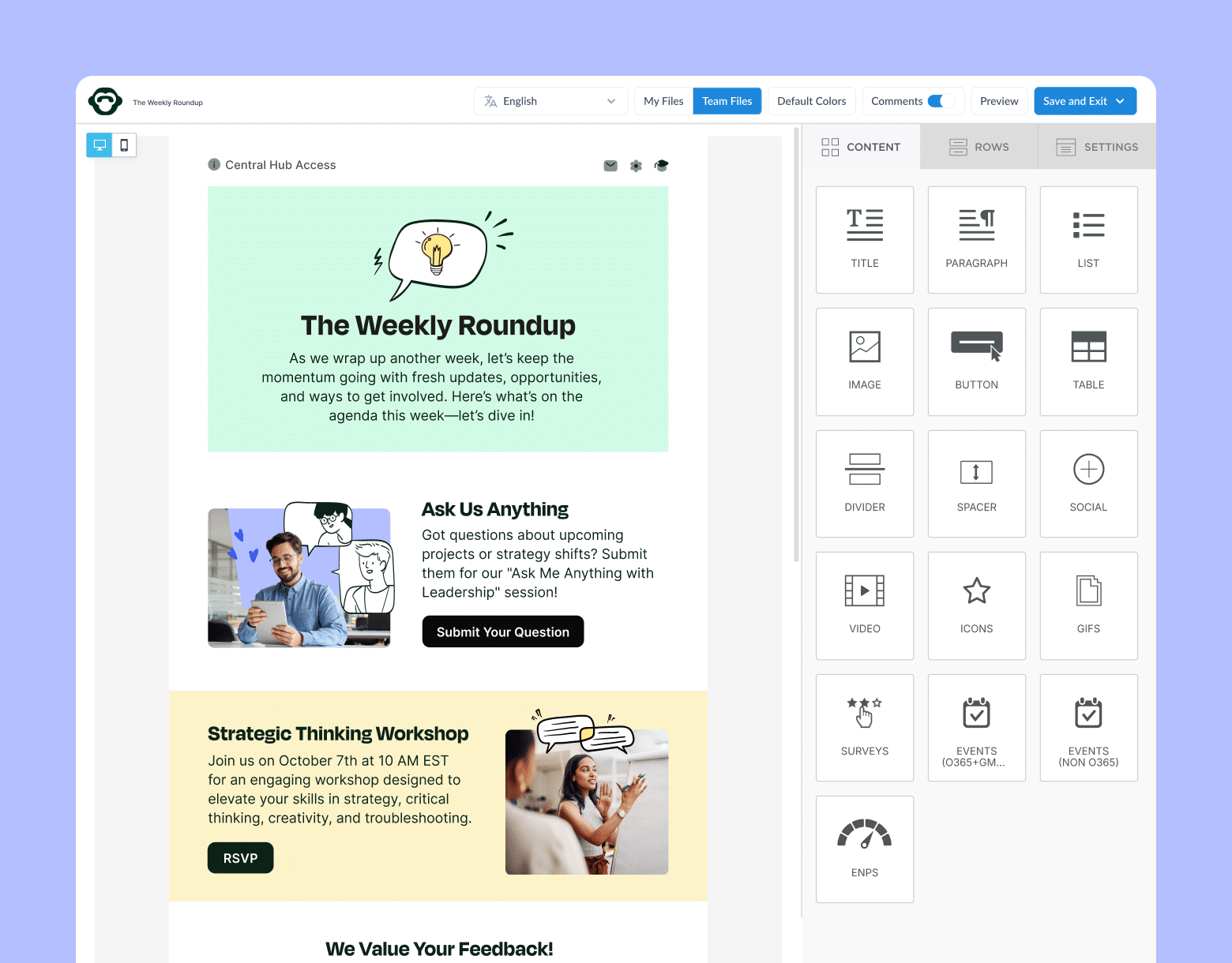
7. Organization culture surveys
The prime focus of organizational culture surveys is to understand how employees see their workplace environment. That includes their relationship with peers and what sorts of habits, attitudes, and practices they see as constituting the office norm.
Survey questions to include:
- Do you feel comfortable sharing your ideas with your peers and team leaders? (scale rating)
- The senior leadership team contributes to a positive workplace culture (scale rating)
- Has your connection to your coworkers been affected by remote work? (yes/no)
- Describe your company culture in three words (anonymous comment)
8. Employer improvement surveys
Offering your employees a chance to express direct and constructive criticism towards your leadership team is essential for making improvements from the top. Gathering this sort of feedback will let you make informed changes to your management style and improve your employee experience.
Likert Scale feedback is the standard for this type of staff survey. It let’s employees give more precise and definitive feedback. For more detail, ask employees a fill-in-the-blank style question for their personalized input.
Make sure to use an employee feedback tool with anonymous commenting like ContactMonkey, so that employees can feel confident giving honest responses. Providing negative feedback to an employer can be scary but it’s essential in order for improvements to take place.
Survey questions to include:
- My manager communicates clear goals for our team (yes/no).
- My manager considers my ideas and input when it comes to team decision-making (scale rating).
- My manager motivates employees and is able to boost team morale (scale rating).
- My manager should continue to ____. / My manager should start to ____.
9. Employee experience/opinion surveys
Employee experience involves each stage of your employee’s lifecycle at their workplace – from their first to their last day with the company. It determines not only how your employees feel at your workplace, but why future hires should want to join your company.
An employee experience survey takes a well-rounded look at different aspects of your employee’s work with the company. Consider it a mix between an employee engagement survey, satisfaction survey and professional development survey.
Survey questions to include:
- My organization promotes a healthy work-life balance. (scale rating)
- I am provided with the necessary tools and resources to do my job well. (yes/no)
- My work environment complements my working style. (scale rating)
- How would you rate your overall workplace experience? (scale rating)
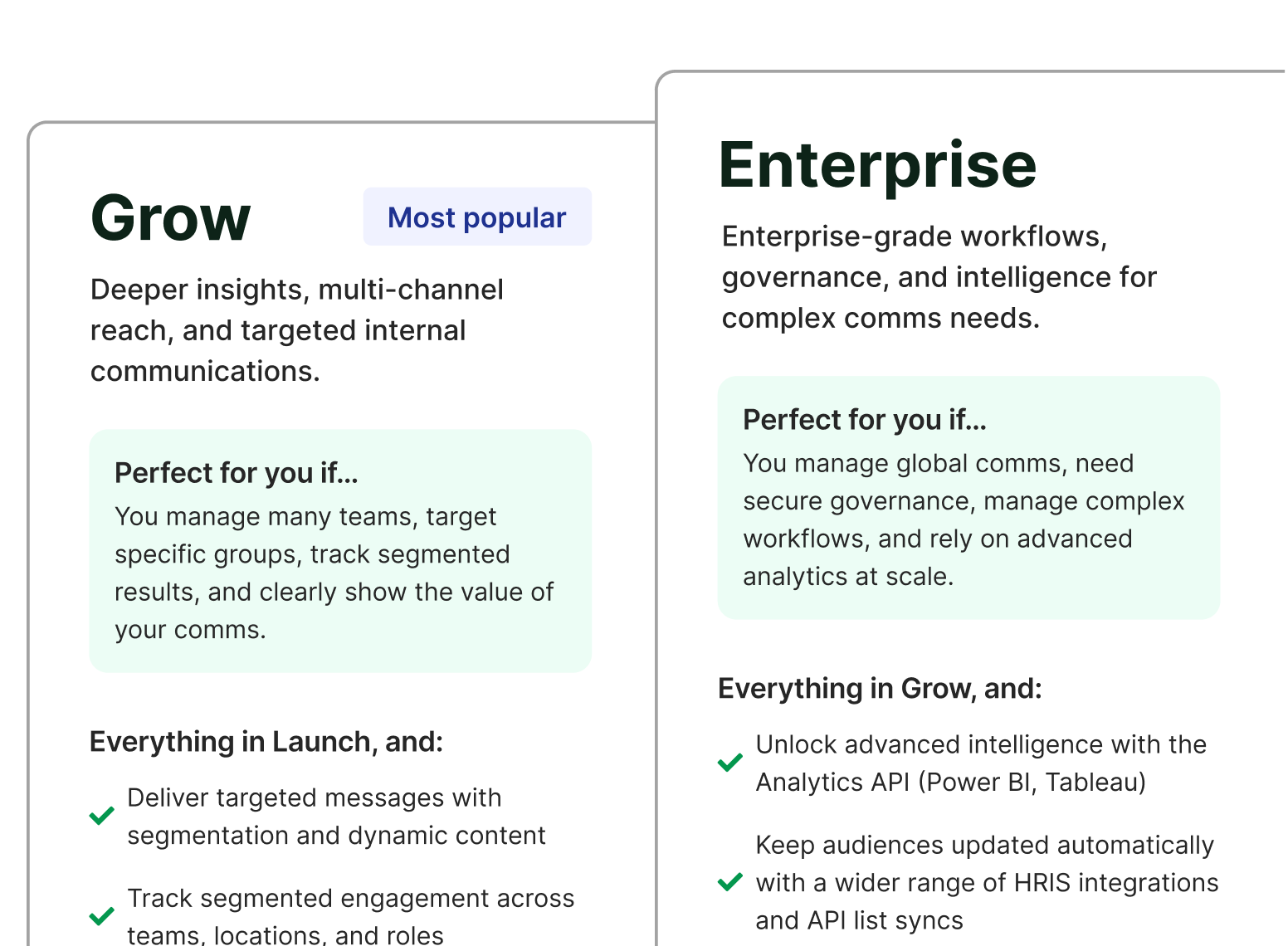
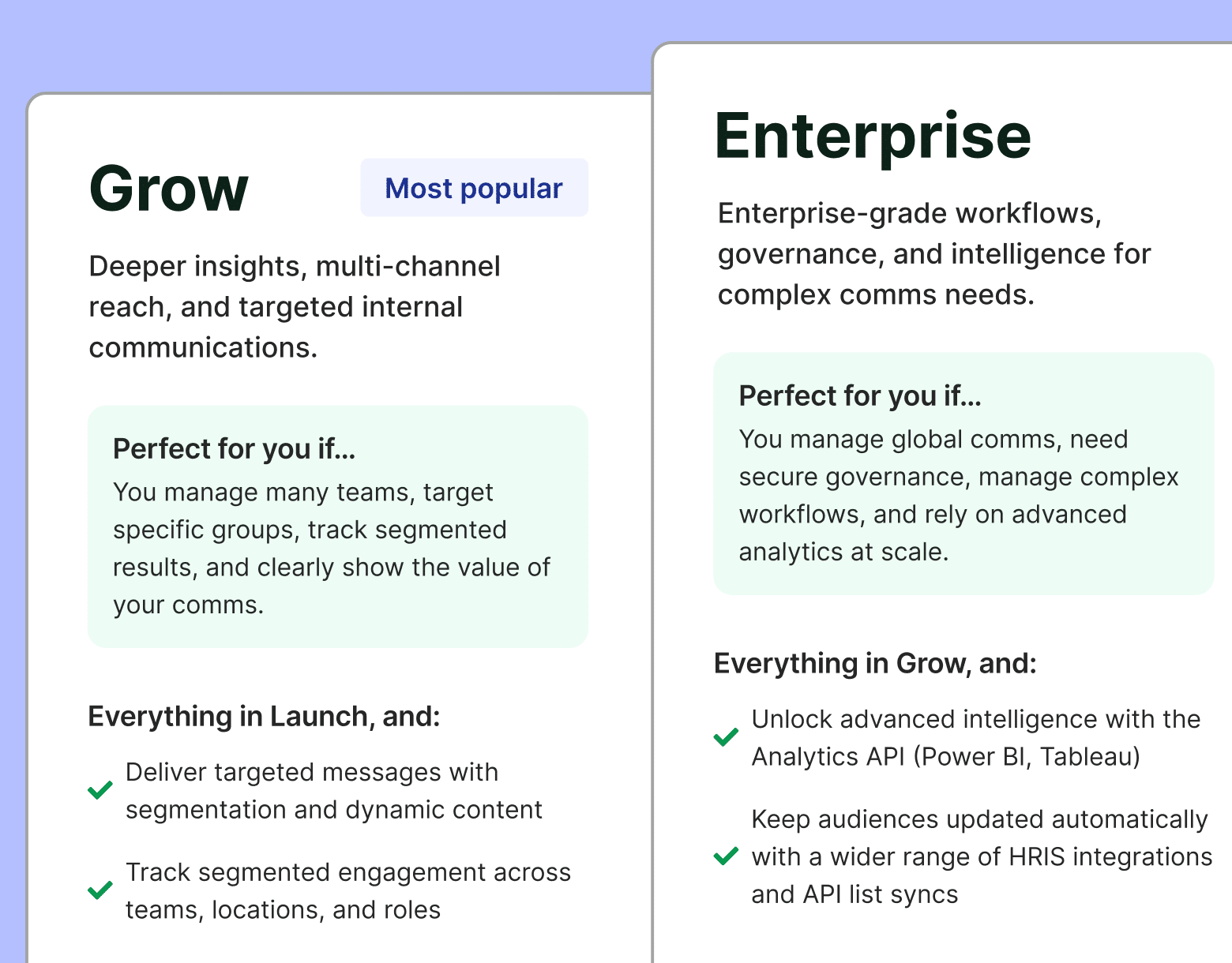
10. Employee onboarding survey
For a new hire, the first few weeks can be decisive for their relationships with your team, how they adapt to company culture and more. There’s also a lot of new information being thrown at them, so employers need to see how they’re doing without adding to the pressure.
An employee onboarding survey will help you check what’s working and what’s not for your new hire as well as any resources they may need. Your survey needs to be short, simple, and straightforward so it’s easy for your new employees to complete without feeling overwhelmed.
To simplify things, try spreading out your employee onboarding survey across the span of a few weeks. With ContactMonkey, you can send to a group of new hires and include an employee pulse survey with one question each week.
You can even organize and segment employee sending lists to target the right employees with the right information using ContactMonkey’s Human Resource Information System(HRIS) integration.
Survey questions to include:
- I feel welcomed at this company. (emoji rating)
- There is enough support/information for me to complete the onboarding process. (yes/no)
- What’s one thing we could have done differently to improve the first week of your onboarding experience? (anonymous comment)
11. Business process surveys
Business processes are sets of tasks and systems designed with the ultimate goal of delivering a product or service to a client. Since your employees are at the forefront of these processes, their feedback is vital.
With the right questions, a business process survey can help managers get concrete and actionable information to improve and streamline company tasks.
Survey questions to include:
- My team uses the necessary tools and technology to complete our tasks well (star rating)
- Innovation and improvement plays a key role in my company’s business processes (star rating)
- There are few bottlenecks in our business processes (yes/no)
- My team can improve business processes by____.
12. Change management survey
Change management pulse surveys are designed to help employers plan, communicate, and implement change in a way that’s aligned with their team.
By zeroing in on employee feedback at specific and semi-regular points in the change management process, pulse surveys pinpoint problem areas so you can address issues and avoid bracing against a current of change resistance.
Include questions that are specific and related to your change, such as an employee’s experience with new software. Balance this with questions pertaining to employees’ general ability to adapt to change.
Survey questions to include:
- Do you feel that our new software would increase your team’s productivity? (yes/no)
- What tools do you use most in your role? (anonymous comment)
- I am optimistic about our upcoming change initiative. (emoji reactions)
- What resources would help guide you through this change initiative? (anonymous comment)
13. Employee wellness survey
Employee engagement is directly linked to employee wellbeing and health. The range of health and wellness initiatives offered by your company as well as the work-life balance at your workplace determine both employee wellbeing and business success.
Conducting an employee wellness survey will let you gauge the level of employee wellbeing at your workplace. It should equally let you recognize gaps or opportunities in your wellness programs.
Survey questions to include:
- What has been the biggest challenge for you while working remotely? (anonymous comment)
- I get enough sleep and feel vibrant throughout the day. (yes/no)
- I listen to my body when there is something wrong and seek assistance when needed. (scale rating)
- I feel that my company supports my wellbeing? (yes/no)
14. Employee opinion survey
Employee opinion surveys combine the elements of an employee attitude survey, a satisfaction survey and engagement survey. The focus is on what beliefs your employees hold about the company.
You want to see how your employees perceive your company and if their beliefs are aligned with your brand identity. Say your company positions itself as an inclusive environment with a fun, easy-going company culture. But your employees see your workplace as strict and authoritative. There is clearly a disconnect. By identifying it you’ll be able to address it.
Survey questions to include:
- I think that things generally operate well in my organization. (yes/no)
- I believe my managers have their employees’ best interests in mind. (yes/no)
- Is there a person in the organization that motivates/inspires you? (yes/no)
- Do you find your managers/supervisors approachable when you have doubts or concerns you’d like to ask about? (yes/no)
7 ways to get honest feedback from employee surveys
Will your workforce tell the truth? Foster trust and openness with your employee using these tips.
Download tips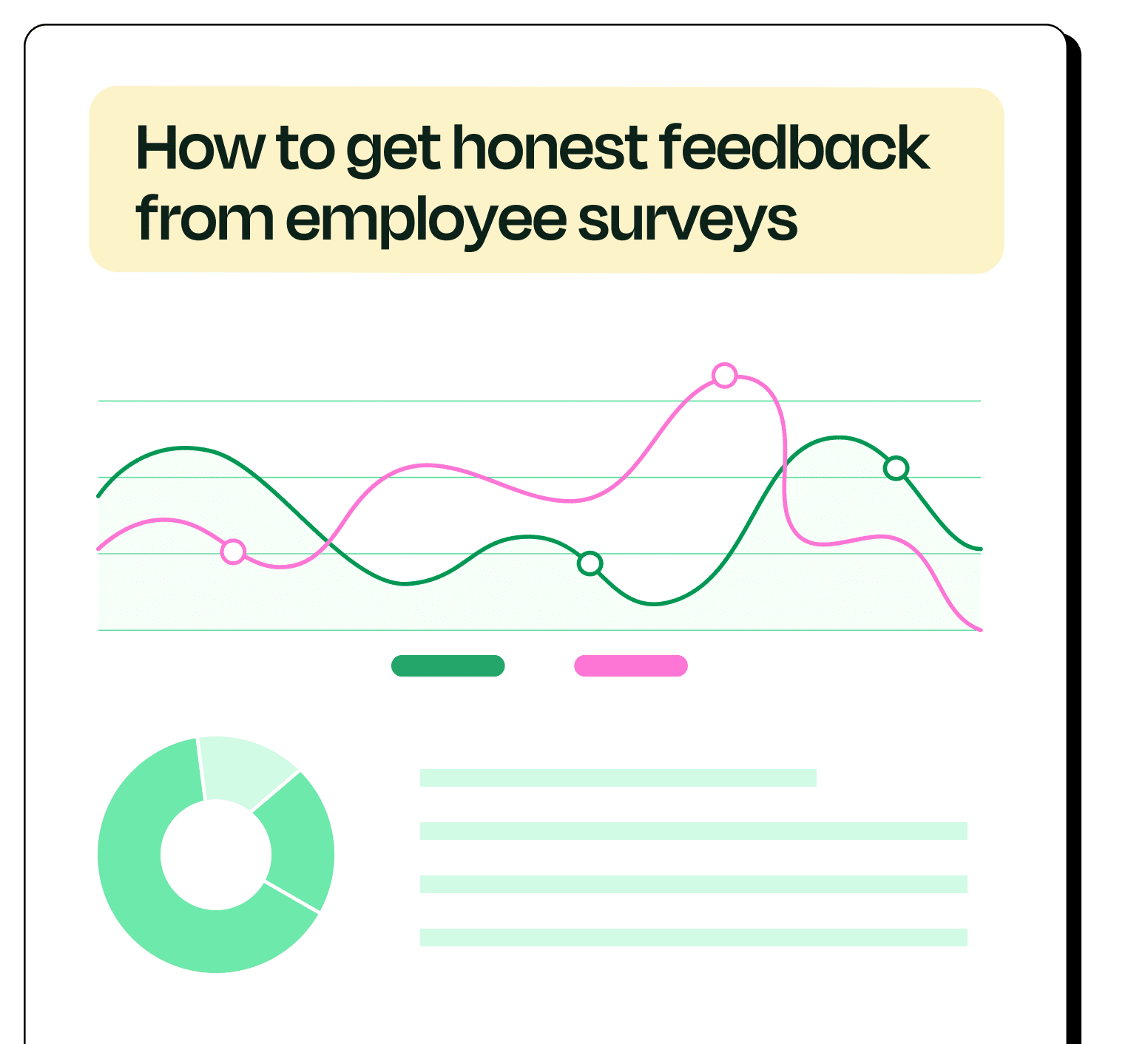
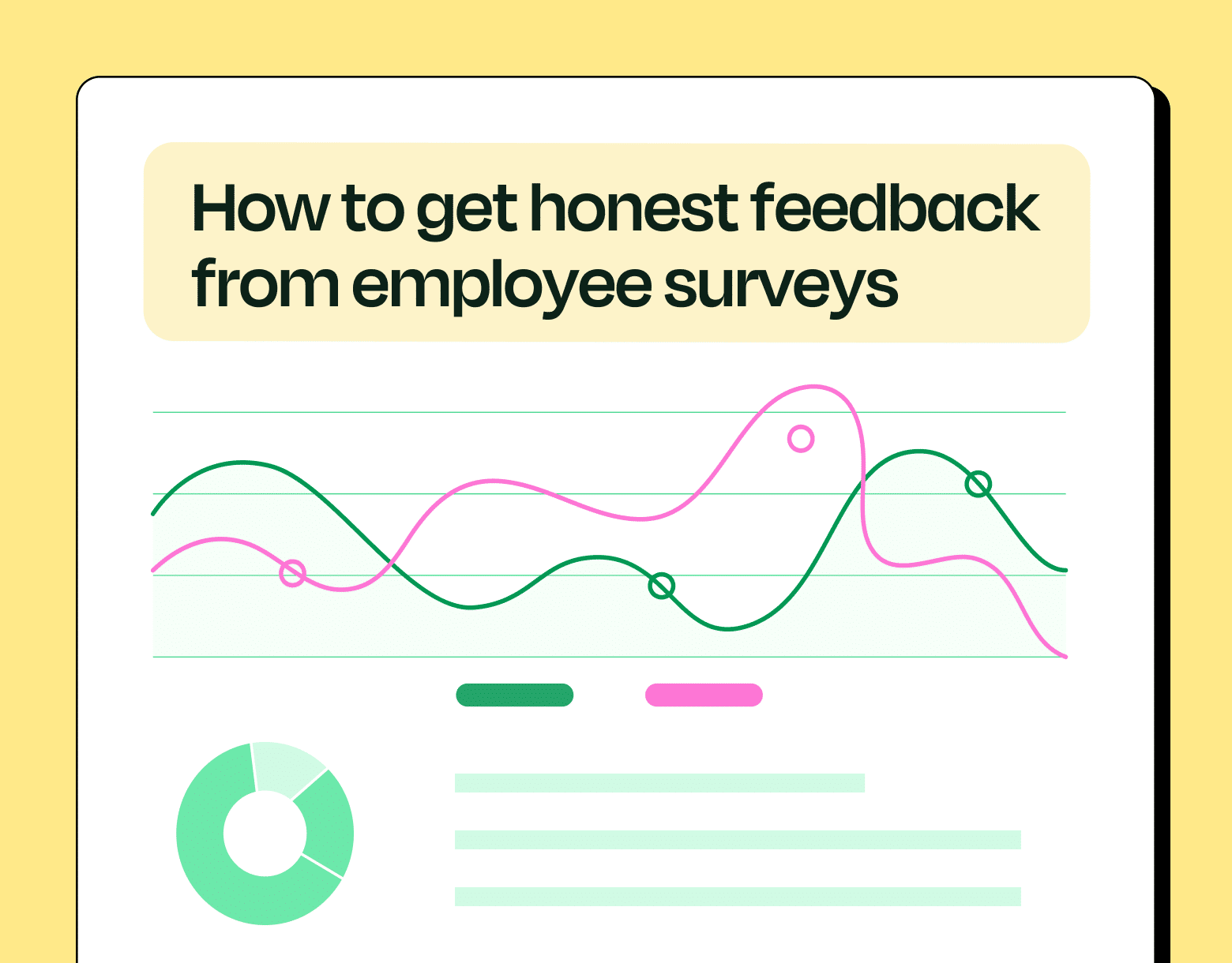
15. Custom survey
You shouldn’t have to feel limited by one survey structure or focus. If you want to explore more than one topic or try out different employee survey styles to see what resonates with your teams, custom surveys are the way to go. Try things out, mix and match questions, and see what works and what doesn’t for your teams.
Once you’ve created your custom employee survey, embed it into your weekly newsletter and check how your staff engaged with it in comparison with previous surveys. With a campaign comparison tool like ContactMonkey, you can monitor engagement and response rates, find the best times to send your employee surveys and more.
For more content ideas, check out our guide to the best types of staff content you can create.
Your Takeaway:
Your employee feedback is as good as the employee feedback survey you design. Choosing the right type of employee survey and questions can make all the difference. When your survey is clear, simple and suited to your goals, the feedback you get will be just as effective.
Next: Learn what to do with your employee engagement survey results.
With a tool like ContactMonkey, you’ll be able to streamline the survey process and get in-depth data when it’s time to plan and act on your insights.

